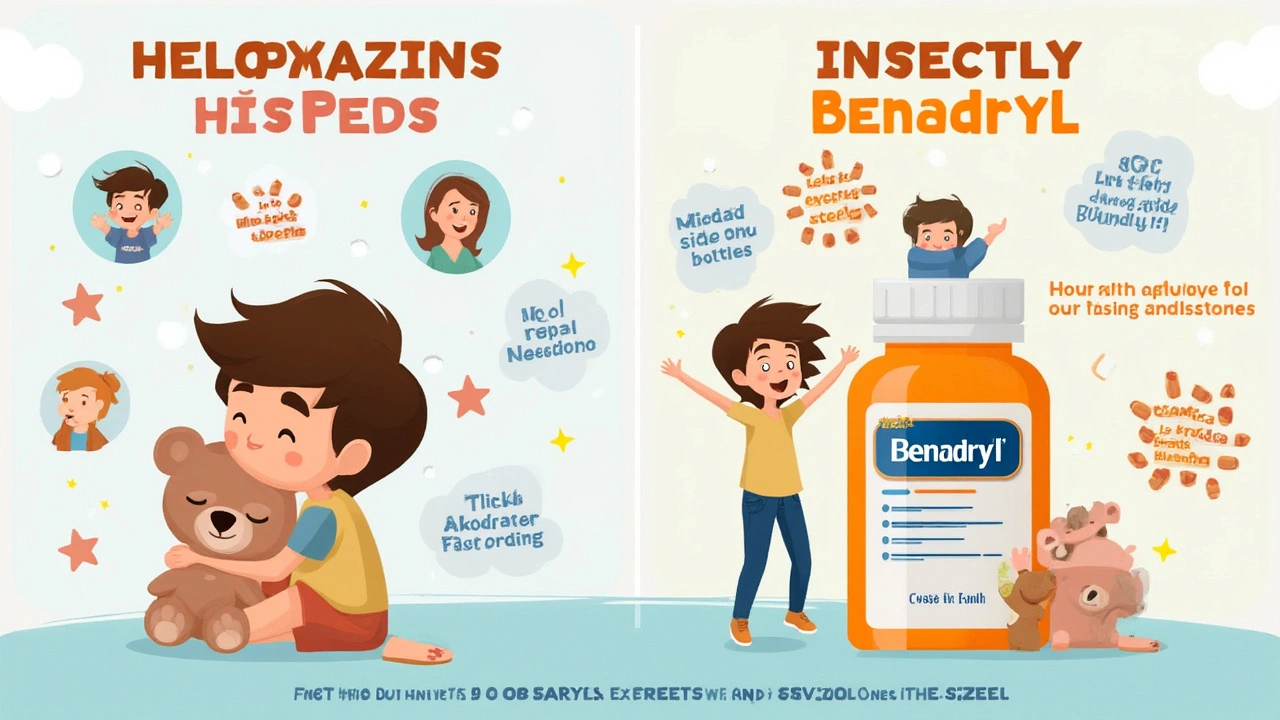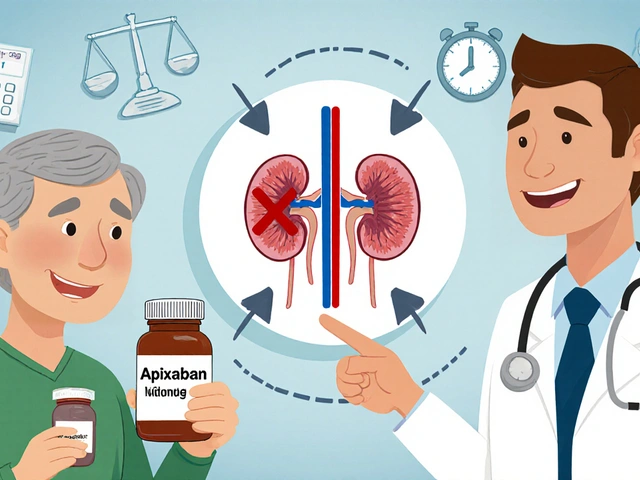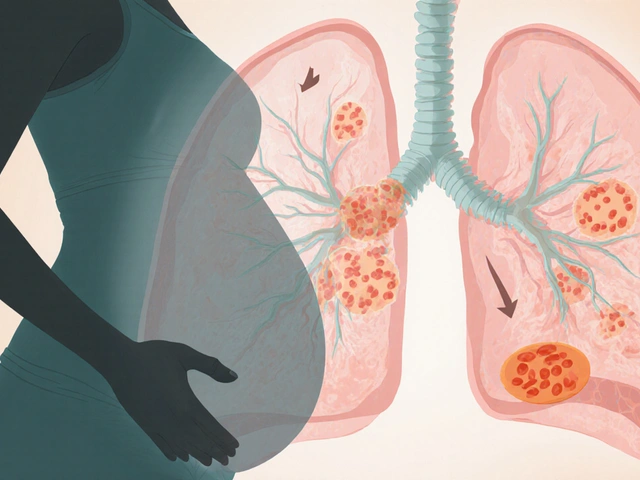Picture this: Your little one wakes up with a runny nose, itchy skin, or a full-blown allergic meltdown at the most inconvenient hour. Not a great way to start the day—or to end it. You punch 'best antihistamine for kids' into your search, and boom—the choices seem endless. Two names pop up a lot: hydroxyzine and Benadryl. Maybe you’ve used one. Maybe you dread both because you’ve heard stories about zombie-like side effects or dosing confusion. What’s actually safer, softer on your child, or just gets the job done?
How Do Hydroxyzine and Benadryl Stack Up?
If you've ever stood wide-eyed in a Boots aisle looking at the countless antihistamines, you’re not alone. Benadryl (that’s diphenhydramine, in science speak) has been around since your parents were kids. It’s a first-generation antihistamine, which means it's part of the older crowd of allergy meds. Hydroxyzine came into the scene a little later, in the 1950s. Both drugs block histamine—the stuff responsible for sneezing, itching, and other allergic chaos. So far, so similar, right?
The main catch: first-generation antihistamines like Benadryl enter the brain easily, causing more sedation and drowsiness. That explains why some parents joke that Benadryl ‘knocks kids out’. Hydroxyzine is also a first-generation antihistamine but is often preferred by paediatricians in the UK for more stubborn cases—especially if itching or anxiety are making your child miserable at night.
Hydroxyzine has another trick: besides blocking histamine, it also targets anxiety and agitation. While Benadryl’s effects tend to last about four to six hours, hydroxyzine stretches further—lasting six to eight hours, sometimes longer. This gets practical if your child struggles with intense itching from eczema or hives that keeps them up (and keeps you from sleeping too). Longer relief matters.
Most people assume Benadryl is more potent just because it’s everywhere. But in direct comparisons, hydroxyzine is at least as effective at cooling down hives, calming skin, and quelling allergic flair-ups. Some studies show hydroxyzine works especially well in kids who don’t respond to the usual antihistamines. In fact, it often gets used in hospitals for severe reactions, oversensitive skin, or even to help settle anxious children before surgeries.
Benadryl’s biggest advantage is speed. It usually kicks in within 15 to 30 minutes, which can be helpful during sudden attacks. Hydroxyzine works quickly too but may take a bit longer to hit full strength. Still, the longer duration of hydroxyzine can mean fewer doses per day—always a win when trying to wrangle a squirmy toddler or a child who hates medicine. If you want more specifics on when and how hydroxyzine is used, check out this detailed post on hydroxyzine for kids.
Bottom line: Both are strong players, but how you use them (and how your child reacts) will tip the scales.
Side Effects: The Good, The Bad, and The Unexpected
You’d think finding the right antihistamine would be all about which stops sneezing fastest. But let’s be honest—side effects are the part that can make or break your trust in a medicine. Benadryl’s reputation as a sedative is no joke. Many parents have stories about kids who practically melt after a dose, turning quiet or even unresponsive for hours. There’s a reason US doctors are backing away from recommending Benadryl as the first choice for kids, especially under age six.
Hydroxyzine also makes kids sleepy, but people report it’s more of a gentle sleepiness—think drifting off rather than dropping off a cliff. The sedation can work in your favour if itchiness is causing disturbed sleep. Still, some children (especially toddlers and babies) react differently. Oddly enough, a minority will get wired or even irritable—so it pays to test a small dose before bedtime, just in case your little one is the outlier.
Here’s one thing a lot of people miss: Benadryl, especially with repeated dosing, can actually cause paradoxical excitement—hyperactivity, trouble sleeping, even nightmares. Kids under five are especially prone to this. Benadryl and hydroxyzine both can trigger dry mouth, blurred vision, constipation, and even trouble urinating, though these are much less common at typical children’s doses.
Worried about safety in the long run? Repeated use of either medicine isn’t ideal. There are hints in research that first-generation antihistamines could affect attention and memory with frequent use. Basically, neither should be a daily habit unless a doctor says so. For mild seasonal sniffles or allergies, most paediatricians reach for newer, less sedating antihistamines instead.
If your child has preexisting heart conditions, hydroxyzine does demand a bit more caution—it can rarely affect heart rhythms. Benadryl, for its part, can interact with a wider range of medicines (think cough syrup, certain antidepressants, or alcohol in teens).
Here’s a quick snapshot if you like numbers:
| Side Effect | Benadryl (Diphenhydramine) | Hydroxyzine |
|---|---|---|
| Drowsiness | Common, often profound | Common, usually milder |
| Paradoxical excitement | Occasional | Rare |
| Dry mouth | Moderate risk | Lower risk |
| Constipation | Possible | Rare |
| Rare heart issues | Very rare | Slightly more with existing problems |

Dosing Differences: Why One Size Never Fits All
Dosing children’s medicines is rarely a straight shot, and antihistamines are no exception. Benadryl is available over-the-counter, and you’ve probably seen the familiar pink bottle. But here’s the snag: there’s a narrow window between an effective dose and an overly sedating (or even potentially dangerous) one, especially for kids under six. In fact, the NHS generally recommends avoiding Benadryl entirely in children under six – and only cautiously in older children.
Benadryl dosing usually goes by age brackets or body weight, for example:
- Children aged 6-12: Usually 12.5 to 25mg every 4-6 hours, not exceeding 150mg per day.
- Teens (over 12): Typical adult dosing applies, but always check the maximum daily dose.
For children under six, doctors may opt for different antihistamines entirely, as the risk of drowsiness, overdose, or paradoxical reactions climbs fast. The nightmare scenario? Parents accidentally double the dose, thinking it’s harmless, or miscalculate with a kitchen spoon—leading to serious drowsiness, breathing problems, or emergency visits. Always use a proper medicine syringe or dosing spoon.
Hydroxyzine is prescription-only in the UK. It’s measured more precisely, based on your child's exact weight (usually 0.5 to 1 mg per kg, up to three times daily, never exceeding a total of 100mg per day for kids). Because it comes in oral syrup and tablets, it’s generally easier to fine-tune and avoids the wild swings of Benadryl. Doctors will adjust the dose if your child is on other medication, or has health concerns like kidney or liver conditions. Reactions, of course, can still vary between kids, so a paediatrician’s input is key.
One smart tip: Write doses down somewhere visible, like a whiteboard or phone notes, and double-check every dose—especially if different adults care for your child. And stash all antihistamines well out of reach; both Benadryl and hydroxyzine can be dangerous with accidental double dosing, or if a curious toddler gets into the bottle.
Here’s a quick table to make sense of the numbers:
| Medicine | Dosing Method | UK Over-the-Counter Age | Prescription Needed? |
|---|---|---|---|
| Benadryl | Age/weight bands | 6 years+ | No |
| Hydroxyzine | Weight-based (mg/kg) | N/A (prescription-only) | Yes |
Tips and Takeaways for Parents Choosing an Antihistamine
Navigating allergies or hives is stressful enough without adding medicine confusion to the mix. When your child is itching, sneezing, or breaking out in hives, you want answers—not a guessing game. If you’re torn between hydroxyzine and Benadryl, start with these practical questions:
- How fast do you need relief? Benadryl acts quickly but is short-lived, while hydroxyzine works longer (and may require fewer daily doses).
- Are you worried about drowsiness? Both cause it, but Benadryl tends to have a heavier sedating punch, especially in younger kids.
- Is your child under six? In the UK, it's best to talk to your GP before trying either—many doctors now recommend non-sedating antihistamines, like cetirizine or loratadine, first for milder allergies.
- What’s the root cause? For stress-related or anxiety-driven itch, hydroxyzine often outshines Benadryl thanks to its mild calming side benefit.
- Does your child take other meds? Always check with a pharmacist. Both antihistamines have possible drug interactions, but Benadryl interacts with many common medicines.
If you’re curious about a deeper dive into hydroxyzine for kids—its uses, safety, and how to dose accurately—check out that trusted post from UK paediatric experts I linked earlier. No fluff, just honest answers.
Don’t forget the basics: For everyday hay fever or mild allergies, try lifestyle tweaks with your medicines. Keep windows closed on high pollen days, use saline sprays, and wash kids’ hands and faces after outdoor play. Antihistamines are just one part of your allergy toolkit, not the whole game.
And a final word—if you ever see a sudden swelling of the lips, tongue, or face, trouble breathing, or your child seems floppy or confused after an antihistamine dose, call emergency services straight away. Better safe than sorry, and most paediatricians would rather see a false alarm than miss a real reaction.
Choosing the right antihistamine can be a headache, but a little inside info goes a long way. Drop the stress, trust your instincts, and always cross-check with your child’s doctor. Allergy season doesn’t have to win—and neither does confusion at the pharmacy shelf.







Steve Smilie
June 3, 2025 AT 18:59 PMOne must contemplate the pharmacokinetic nuances of hydroxyzine versus diphenhydramine; the former boasts a prolonged half-life that can be advantageous for nocturnal pruritus.
The molecular architecture confers a modestly higher lipid solubility, permitting a gentle traversal of the blood‑brain barrier.
Consequently, the sedative phenotype, while present, tends toward a mellifluous drowsiness rather than the abrupt knockout associated with Benadryl.
Such subtleties merit appreciation beyond the pedestrian OTC shelves.
Josie McManus
June 6, 2025 AT 13:39 PMKiddo's sleep is priceless.
Heather Kennedy
June 9, 2025 AT 08:19 AMFrom a pharmacodynamic perspective, both agents antagonize H1 receptors, yet hydroxyzine exhibits ancillary anxiolytic activity via central α2‑adrenergic modulation.
This multimodal action can attenuate the neurogenic itch cascade, especially in atopic dermatitis.
Clinicians often leverage this property when monotherapy fails, integrating dosage titration based on kg body weight rather than the crude age brackets typical of diphenhydramine.
In practice, the weight‑based schema reduces the margin of error for pediatric dosing.
Janice Rodrigiez
June 12, 2025 AT 02:59 AMPro tip: always use the supplied oral syringe for measuring pediatric doses; a kitchen spoon can vary by up to 30 percent.
Even a slight overdose of diphenhydramine can plunge a toddler into a profound sedation state.
Roger Cardoso
June 14, 2025 AT 21:39 PMWhat the mainstream doesn’t tell you is that the pharmaceutical lobby subtly promotes benadryl as a ‘miracle cure’ to funnel cash into their supply chains.
The slight increase in sedation is merely a side‑effect engineered to keep parents dependent on OTC aisles.
barry conpoes
June 17, 2025 AT 16:19 PMAccording to the latest CDC pediatric guidelines, hydroxyzine is preferred when you need coverage that lasts through the night without waking the whole household.
Benadryl’s rapid onset is useful for emergency flare‑ups, but the trade‑off is a crash that can leave a child groggy for hours.
Kristen Holcomb
June 20, 2025 AT 10:59 AMHey there, just a friendly reminder to double‑check the concentration of the syrup before you draw up the dose.
Even a tiny typo in the label can throw off the whole calculation, and we’ve all seen kids turn into little zombies when that happens.
justin davis
June 23, 2025 AT 05:39 AMWow!!! Another parent discovering that Benadryl turns kids into sleep‑walking ninjas!!!
Did you also notice that the “quick‑hit” is basically a turbo‑charged nap?
Ask yourself: is that really a benefit or just a shortcut to a mini‑coma???!!!
David Lance Saxon Jr.
June 26, 2025 AT 00:19 AMThe ontological implications of choosing an antihistamine for a minor are profound; we are, in effect, mediating the child's subjective experience of discomfort.
Hydroxyzine, with its dual antihistaminic and anxiolytic profile, offers a more holistic approach to symptom management.
Conversely, diphenhydramine’s pharmacological simplicity may reflect a reductionist mindset prevalent in fast‑track pharmaceuticals.
Thus, the decision transcends mere efficacy and touches on the philosophical stance one adopts toward pediatric care.
Moore Lauren
June 28, 2025 AT 18:59 PMQuick cheat‑sheet: start with the lowest weight‑based dose of hydroxyzine, reassess after 30 minutes, and only increase if itching persists.
No need to jump straight to the adult dosage.
Jonathan Seanston
July 1, 2025 AT 13:39 PMTotally agree with the holistic view-balancing efficacy and side‑effects is key. Thanks for the clear cheat‑sheet!
Sukanya Borborah
July 4, 2025 AT 08:19 AMThis whole post could use better formatting; the tables are hard to read on mobile, and the language is needlessly verbose.
bruce hain
July 7, 2025 AT 02:59 AMWhile the points raised are valid, one must also consider the regulatory disparities between regions that influence prescribing habits.
Stu Davies
July 9, 2025 AT 21:39 PMGreat summary! 😊 It really helped me decide which one to ask my pediatrician about.
Nadia Stallaert
July 12, 2025 AT 16:19 PMLet us delve deep into the labyrinthine corridors of pediatric antihistamine selection, for the choice between hydroxyzine and diphenhydramine is not a mere transactional decision but a profound ethical conundrum that reflects the very fabric of modern healthcare governance.
First, consider the pharmacokinetics: hydroxyzine, with its extended half‑life, offers a sustained therapeutic window that can bridge the nocturnal itch, whereas benadryl’s rapid absorption comes at the price of a precipitous trough that may necessitate multiple administrations, thus increasing the risk of dosing errors.
Second, the sedative profile: while both agents cross the blood‑brain barrier, hydroxyzine’s sedation is often described as a gentle lulling, akin to a soft lullaby, whereas benadryl can produce an abrupt, almost comatose state that borders on the dystopic.
Third, the ancillary anxiolytic properties of hydroxyzine should not be dismissed; they provide a dual‑action benefit in children whose allergic flares are compounded by anxiety, a factor increasingly recognized in pediatric allergology.
However, one must not overlook the potential cardiac considerations; hydroxyzine, though rare, has been associated with QT prolongation in susceptible individuals, mandating electrocardiographic vigilance in at‑risk populations.
In contrast, diphenhydramine’s cardiac risk profile is comparatively negligible, albeit not entirely absent, especially when combined with other QT‑prolonging agents.
Furthermore, the regulatory landscape paints a complex picture: in the UK, hydroxyzine remains prescription‑only, reinforcing a prescriber‑driven safety net, whereas benadryl is freely available OTC in many jurisdictions, inviting layperson misuse.
Such accessibility can be a double‑edged sword, providing rapid relief in emergencies but also fostering inadvertent overdoses-an especially pernicious threat in households with multiple caregivers.
Turning to the economic dimension, the cost differential is non‑trivial; hydroxyzine’s prescription status can impose additional financial burdens on families, whereas benadryl’s ubiquitous presence in discount aisles may appear more economical at first glance.
Nevertheless, the hidden costs of potential side‑effects, emergency department visits, and missed work days for caregivers must be factored into any comprehensive cost‑benefit analysis.
From a sociocultural perspective, parental expectations often drive the selection of a “quick fix,” yet educational initiatives emphasizing the importance of weight‑based dosing and the dangers of off‑label use can shift this paradigm toward more informed decision‑making.
Moreover, the psychological impact on the child cannot be understated; exposure to repeated sedation may affect daytime cognition, attention span, and academic performance, underscoring the need for judicious use of any first‑generation antihistamine.
In light of the burgeoning availability of second‑generation, non‑sedating antihistamines such as cetirizine and loratadine, the default reliance on hydroxyzine or benadryl warrants reevaluation.
Ultimately, the clinician’s role is to tailor therapy to the individual child’s disease severity, comorbidities, and lifestyle, while parents must remain vigilant custodians of dosing precision and monitor for adverse events.
Thus, the decision matrix is multidimensional, integrating pharmacology, safety, economics, and psychosocial factors into a singular, patient‑centered strategy.
Greg RipKid
July 15, 2025 AT 10:59 AMJust to add, keep an eye on any dry mouth or constipation – they’re common with both meds but usually mild.
John Price Hannah
July 18, 2025 AT 05:39 AMHonestly, watching a toddler wobble into dreamland after a dose feels like watching a tiny, trembling ghost-beautiful and terrifying all at once!!!
Echo Rosales
July 21, 2025 AT 00:19 AMMaybe we’re overthinking it; a simple syrup dose works fine for most kids.
Elle McNair
July 23, 2025 AT 18:59 PMLet’s remember that both options are tools; the best choice aligns with the child’s comfort and the family’s routine.
Dennis Owiti
July 26, 2025 AT 13:39 PMHope this helps everyone find the right balance – your kid’s wellbeing is worth the extra research!